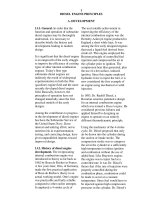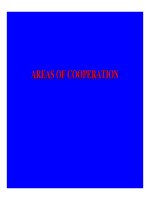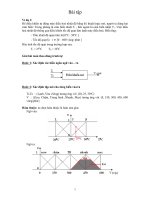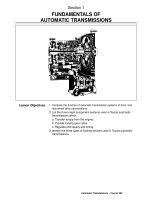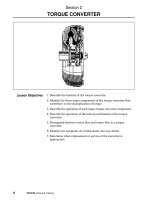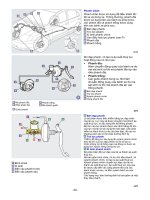Tài liệu Maintenance Fundamentals P1 doc
Bạn đang xem bản rút gọn của tài liệu. Xem và tải ngay bản đầy đủ của tài liệu tại đây (392.08 KB, 30 trang )
MAINTENANCE
FUNDAMENTALS
2nd Edition
Keith Mobley /Maintenance Fundamentals Final Proof 15.6.2004 4:42pm page i
P
LANT
E
NGINEERING
M
AINTENANCE
S
ERIES
Vibration Fundamentals
R. Keith Mobley
Root Cause Failure Analysis
R. Keith Mobley
Maintenance Fundamentals
R. Keith Mobley
Keith Mobley /Maintenance Fundamentals Final Proof 15.6.2004 4:42pm page ii
MAINTENANCE
FUNDAMENTALS
2nd Edition
R. Keith Mobley
AMSTERDAM • BOSTON • HEIDELBERG • LONDON • NEW YORK • OXFORD
PARIS • SAN DIEGO • SAN FRANCISCO • SINGAPORE • SYDNEY • TOKYO
Keith Mobley /Maintenance Fundamentals Final Proof 15.6.2004 4:42pm page iii
Elsevier Butterworth–Heinemann
200 Wheeler Road, Burlington, MA 01803, USA
Linacre House, Jordan Hill, Oxford OX2 8DP, UK
Copyright # 2004, Elsevier Inc. All rights reserved.
No part of this publication may be reproduced, stored in a retrieval system, or transmitted
in any form or by any means, electronic, mechanical, photocopying, recording, or
otherwise, without the prior written permission of the publisher.
Permissions may be sought directly from Elsevier’s Science & Technology Rights
Department in Oxford, UK: phone: (þ44) 1865 843830, fax: (þ44) 1865 853333,
e-mail: You may also complete your request on-line via the
Elsevier homepage (), by selecting ‘‘Customer Support’’ and then
‘‘Obtaining Permissions.’’
Recognizing the importance of preserving what has been written, Elsevier prints its books
on acid-free paper whenever possible.
Library of Congress Cataloging-in-Publication Data
Application submitted
British Library Cataloguing-in-Publication Data
A catalogue record for this book is available from the British Library.
ISBN: 0-7506-7798-8
For information on all Butterworth–Heinemann publications
visit our Web site at www.bh.com
04 05 06 07 08 09 10 10 9 8 7 6 5 4 3 2 1
Printed in the United States of America
Keith Mobley /Maintenance Fundamentals Final Proof 15.6.2004 4:42pm page iv
CONTENTS
Chapter 1 Impact of Maintenance 1
Chapter 2 Fundamental Requirements of Effective
Preventive Maintenance 11
Chapter 3 Designing a Preventive Maintenance Program 25
Chapter 4 Planning and Scheduling 35
Chapter 5 Scheduled Preventive Maintenance 45
Chapter 6 Maintenance Engineering Roles and Responsibilities 55
Chapter 7 Shaft Alignment 71
Chapter 8 Rotor Balancing 112
Chapter 9 Bearings 125
Chapter 10 Couplings 171
Chapter 11 Gears and Gearboxes 201
Chapter 12 Compressors 231
Chapter 13 Control Valves 266
Chapter 14 Conveyors 287
Chapter 15 Fans, Blowers, and Fluidizers 299
Chapter 16 Dust Collectors 317
Chapter 17 Pumps 331
Chapter 18 Steam Traps 365
Chapter 19 Performance Measurement and Management 374
Glossary 390
Index 416
Keith Mobley /Maintenance Fundamentals Final Proof 15.6.2004 4:42pm page v
v
Keith Mobley /Maintenance Fundamentals Final Proof 15.6.2004 4:42pm page vi
This page intentionally left blank
1
IMPACT OF MAINTENANCE
Maintenance costs, as defined by normal plant accounting procedures, are
normally a major portion of the total operating costs in most plants. Traditional
maintenance costs (i.e., labor and material) in the United States have escalated at
a tremendous rate over the past 10 years. In 1981, domestic plants spent more
than $600 billion to maintain their critical plant systems. By 1991, the costs had
increase to more than $800 billion, and they were projected to top $1.2 trillion by
the year 2000. These evaluations indicate that on average, one third, or $250
billion, of all maintenance dollars are wasted through ineffective maintenance
management methods. American industry cannot absorb the incredible level of
inefficiency and hope to compete in the world market.
Because of the exorbitant nature of maintenance costs, they represent the
greatest potential short-term improvement. Delays, product rejects, scheduled
maintenance downtime, and traditional maintenance costs—such as labor,
overtime, and repair parts—are generally the major contributors to abnormal
maintenance costs within a plant.
The dominant reason for this ineffective management is the lack of factual data
that quantify the actual need for repair or maintenance of plant machinery,
equipment, and systems. Maintenance scheduling has been and in many in-
stances still is predicated on statistical trend data or on the actual failure of
plant equipment.
Until recently, middle and corporate level management have ignored the impact
of the maintenance operation on product quality, production costs, and more
importantly on bottom-line profit. The general opinion has been ‘‘maintenance is
Keith Mobley /Maintenance Fundamentals Final Proof 15.6.2004 4:44pm page 1
1
a necessary evil’’ or ‘‘nothing can be done to improve maintenance costs.’’
Perhaps these were true statements 10 or 20 years ago. However, the develop-
ments of microprocessor or computer-based instrumentation that can be used to
monitor the operating condition of plant equipment, machinery, and systems
have provided the means to manage the maintenance operation. They have
provided the means to reduce or eliminate unnecessary repairs, prevent cata-
strophic machine failures, and reduce the negative impact of the maintenance
operation on the profitability of manufacturing and production plants.
M
AINTENANCE
P
HILOSOPHIES
Industrial and process plants typically utilize two types of maintenance manage-
ment: (1) run-to-failure, or (2) preventive maintenance.
Run-to-Failure Management
The logic of run-to-failure management is simple and straightforward. When a
machine breaks, fix it. This ‘‘if it ain’t broke, don’t fix it’’ method of maintaining
plant machinery has been a major part of plant maintenance operations since the
first manufacturing plant was built, and on the surface sounds reasonable.
A plant using run-to-failure management does not spend any money on main-
tenance until a machine or system fails to operate. Run-to-failure is a reactive
management technique that waits for machine or equipment failure before any
maintenance action is taken. It is in truth a no-maintenance approach of
management. It is also the most expensive method of maintenance management.
Few plants use a true run-to-failure management philosophy. In almost all
instances, plants perform basic preventive tasks (i.e., lubrication, machine
adjustments, and other adjustments) even in a run-to-failure environment. How-
ever, in this type of management, machines and other plant equipment are not
rebuilt nor are any major repairs made until the equipment fails to operate.
The major expenses associated with this type of maintenance management are:
(1) high spare parts inventory cost, (2) high overtime labor costs, (3) high machine
downtime, and (4) low production availability. Since there is no attempt to
anticipate maintenance requirements, a plant that uses true run-to-failure man-
agement must be able to react to all possible failures within the plant. This reactive
method of management forces the maintenance department to maintain extensive
spare parts inventories that include spare machines or at least all major compon-
ents for all critical equipment in the plant. The alternative is to rely on equipment
vendors that can provide immediate delivery of all required spare parts. Even if the
latter is possible, premiums for expedited delivery substantially increase the costs
Keith Mobley /Maintenance Fundamentals Final Proof 15.6.2004 4:44pm page 2
2 Maintenance Fundamentals
of repair parts and downtime required for correcting machine failures. To minim-
ize the impact on production created by unexpected machine failures, mainten-
ance personnel must also be able to react immediately to all machine failures.
The net result of this reactive type of maintenance management is higher main-
tenance cost and lower availability of process machinery. Analysis of mainten-
ance costs indicates that a repair performed in the reactive or run-to-failure
mode will average about three times higher than the same repair made within a
scheduled or preventive mode. Scheduling the repair provides the ability to
minimize the repair time and associated labor costs. It also provides the means
of reducing the negative impact of expedited shipments and lost production.
Preventive Maintenance Management
There are many definitions of preventive maintenance, but all preventive main-
tenance management programs are time driven. In other words, maintenance
tasks are based on elapsed time or hours of operation. Figure 1.1 illustrates an
example of the statistical life of a machine-train. The mean time to failure (MTTF)
or bathtub curve indicates that a new machine has a high probability of failure,
because of installation problems, during the first few weeks of operation. After
this initial period, the probability of failure is relatively low for an extended period
of time. Following this normal machine life period, the probability of failure
increases sharply with elapsed time. In preventive maintenance management,
machine repairs or rebuilds are scheduled on the basis of the MTTF statistic.
Break in
or
start up
Number of failures
Time
Normal life
Equipment
worn out
Figure 1.1 Bathtub curve.
Keith Mobley /Maintenance Fundamentals Final Proof 15.6.2004 4:44pm page 3
Impact of Maintenance 3
The actual implementation of preventive maintenance varies greatly. Some
programs are extremely limited and consist of lubrication and minor adjust-
ments. More comprehensive preventive maintenance programs schedule repairs,
lubrication, adjustments, and machine rebuilds for all critical machinery in the
plant. The common denominator for all of these preventive maintenance pro-
grams is the scheduling guideline. All preventive maintenance management
programs assume that machines will degrade within a time frame typical of its
particular classification. For example, a single-stage, horizontal split-case centri-
fugal pump will normally run 18 months before it must be rebuilt. When
preventive management techniques are used, the pump would be removed from
service and rebuilt after 17 months of operation.
The problem with this approach is that the mode of operation and system or
plant-specific variables directly affect the normal operating life of machinery.
The mean time between failures (MTBF) will not be the same for a pump that is
handling water and one that is handling abrasive slurries. The normal result of
using MTBF statistics to schedule maintenance is either unnecessary repairs or
catastrophic failure. In the example, the pump may not need to be rebuilt after 17
months. Therefore the labor and material used to make the repair was wasted.
The second option, use of preventive maintenance, is even more costly. If the
pump fails before 17 months, we are forced to repair by using run-to-failure
techniques. Analysis of maintenance costs has shown that a repair made in a
reactive mode (i.e., after failure) will normally be three times greater than the
same repair made on a scheduled basis.
Predictive Maintenance
Like preventive maintenance, predictive maintenance has many definitions. To
some, predictive maintenance is monitoring the vibration of rotating machinery
in an attempt to detect incipient problems and to prevent catastrophic failure. To
others, it is monitoring the infrared image of electrical switchgears, motors, and
other electrical equipment to detect developing problems.
The common premise of predictive maintenance is that regular monitoring of
the mechanical condition of machine-trains will ensure the maximum interval
between repair and minimize the number and cost of unscheduled outages
created by machine-train failures. Predictive maintenance is much more. It is
the means of improving productivity, product quality, and overall effectiveness
of our manufacturing and production plants. Predictive maintenance is not
vibration monitoring or thermal imaging or lubricating oil analysis or any of
the other nondestructive testing techniques that are being marketed as predictive
maintenance tools. Predictive maintenance is a philosophy or attitude that,
simply stated, uses the actual operating condition of plant equipment and
Keith Mobley /Maintenance Fundamentals Final Proof 15.6.2004 4:44pm page 4
4 Maintenance Fundamentals
systems to optimize total plant operation. A comprehensive predictive mainten-
ance management program utilizes a combination of the most cost-effective
tools—that is, vibration monitoring, thermography, tribology, etc.—to obtain
the actual operating condition of critical plant systems, and based on these actual
data, schedules all maintenance activities on an as-needed basis. Including
predictive maintenance in a comprehensive maintenance management program
will provide the ability to optimize the availability of process machinery and
greatly reduce the cost of maintenance. It will also provide the means to improve
product quality, productivity, and profitability of our manufacturing and
production plants.
Predictive maintenance is a condition-driven preventive maintenance program.
Instead of relying on industrial or in-plant average-life statistics (i.e., MTTF) to
schedule maintenance activities, predictive maintenance uses direct monitoring
of the mechanical condition, system efficiency, and other indicators to determine
the actual MTTF or loss of efficiency for each machine-train and system in the
plant. At best, traditional time-driven methods provide a guideline to normal
machine-train life spans. The final decision, in preventive or run-to-failure
programs, on repair or rebuild schedules must be made on the bases of intuition
and the personal experience of the maintenance manager. The addition of a
comprehensive predictive maintenance program can and will provide factual
data on the actual mechanical condition of each machine-train and operating
efficiency of each process system. These data provide the maintenance manager
with actual data for scheduling maintenance activities.
A predictive maintenance program can minimize unscheduled breakdowns of all
mechanical equipment in the plant and ensure that repaired equipment is in
acceptable mechanical condition. The program can also identify machine-train
problems before they become serious. Most mechanical problems can be minim-
ized if they are detected and repaired early. Normal mechanical failure modes
degrade at a speed directly proportional to their severity. If the problem is
detected early, major repairs, in most instances, can be prevented. Simple vibra-
tion analysis is predicated on two basic facts: all common failure modes have
distinct vibration frequency components that can be isolated and identified, and
the amplitude of each distinct vibration component will remain constant unless
there is a change in the operating dynamics of the machine-train. These facts,
their impact on machinery, and methods that will identify and quantify the root
cause of failure modes will be developed in more detail in later chapters.
Predictive maintenance that utilizes process efficiency, heat loss, or other non-
destructive techniques can quantify the operating efficiency of non-mechanical
plant equipment or systems. These techniques used in conjunction with vibration
analysis can provide the maintenance manager or plant engineer with factual
Keith Mobley /Maintenance Fundamentals Final Proof 15.6.2004 4:44pm page 5
Impact of Maintenance 5
